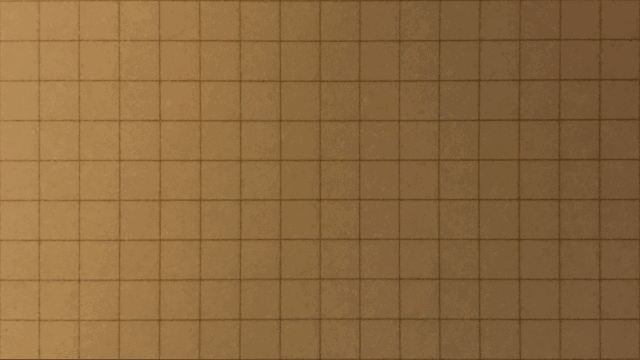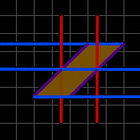Does anyone out there have a foggy, dream-like memory from early childhood that looks something like this?
When this resurfaced and started getting passed around contemporary music circles about ten years ago, it was a little bit like UFO abduction survivors finding each other. We whispered:
"Did you see it too??"
“Oh my god, I thought I… yes… that was Philip?”
“My family never understood. They still think I imagined it. I was starting to believe them.”
This is an animated short by Cathryn Aison, with music by Philip Glass, that originally aired in full on Sesame Street in 1979, and was then broken up into sections and used as interstitial bits in the years that followed. Are you one of the people who had this little chip implanted in your brain between the ages of three and seven? Did it subconsciously radicalize you to Euclidian geometry and NYC minimalism?
I’m here to tell you you’re not alone. I, too, found myself, years later, in a trance at the dinner table, building the set of Einstein on the Beach in my mashed potatoes.
Intuition first, math later
As a five-year-old, sitting on the floor in front of the television, these clips mesmerized me. They always seemed to come out of nowhere, like transmissions from another planet — no words, no explanation, no fuzzy monsters teaching me the alphabet. Just a child-sized glimpse of the organized complexity that exists under the surface of simple things, accompanied by the strange music of happy aliens.
Could these clips partly explain why I’ve always gravitated toward music with mathematical organization, repetitive process, and the sound of that farfisa from Music in Twelve Parts?1 Maybe! I will always argue that it’s the stuff that gets to us early that shapes our aesthetic sweet spots for the rest of our lives.
But more broadly, this video taught me from a young age that one way to head off any potential resistance to mathematics (or any learning, really) is to start with something beautiful, intuitive, and child-like. Simple animation like this makes math mesmerizing, whether you decide to intellectualize it or not.
This clip got a particular type of music and visual into my body early. Looking back, it inspires me to ask… how might other musical ideas could get a similar treatment?
Hole punch
Forty years later, I stumbled upon just intonation, and discovered how musical tones could be organized into a lattice. Finally, finally, an alternative to the bizarre geometry of western classical music notation and its strangely unintuitive version of dots, lines, and spaces.
My brain reflectively clicked into Sesame Street-mode: this is so cool. You could animate this!
Much like The Geometry of Circles, I saw the musical lattice as a framework for demonstrating the simplest fundamentals of music intuitively, in advance of the “theory.”
The problem: I had no art skills whatsoever, and had certainly never used any animation software or even really edited video. It was one of those beginner-mind moments. Inspired by a brilliant artist-musician friend’s foray2 into stop-motion animation, I drew a bunch of dots and got out a hole punch.
The first thing I learned was that the camera needs to be in a fixed position for stop-motion animation to work.
The vibe was very “learn by doing.”
Factor
After a ton of trial and error and a hotel room incident involving spilled googly-eyes, here’s what I eventually came up with:
On thing to note: I originally intended to leave out the numbers completely. But I was also trying to catch the attention of musician friends on social media (note the awkward aspect ratio issues!) — I thought they might recognize the numbers abstractly as harmonics. But if I did it again (and will, below), I’d go with no numbers at all.
The simplest lattice
The exercise with the above video was to compose a little music using the simplest two-dimensional lattice possible, and then add a third dimension. Here’s a little walkthrough:
First Dimension
I chose depth as the first dimension of that lattice.
There’s a line in this first dimension, with several points. Each point represents a frequency (in this case, a pitch), and the difference between each is a 2:1 ratio. You may recognize it as an octave.
Just to really lean into the “Sesame Street Classics” of it all… think of this dimension as “near” and “far.” Like what the fuzzy monsters taught us.3 We perceive the lower frequencies as “near” and the higher frequencies as “far.”4
We’ve started with that 2:1 ratio because it is the simplest interval found in the harmonic series, containing the lowest prime number — two (each new prime number incorporated in the ratios will reveal a new dimension to the lattice).
To continue the meataphor from a couple weeks back, this could be seen as moving from a pointland to a lineland.
Second Dimension
I chose width for the second dimension, which adds new lines extending perpendicularly from each existing point in the first dimension. Left and right.
There will be two new points to the right of each point on the original line. The distance between each point in the second dimension is a 3:1 frequency ratio, which is the next simplest interval found in the harmonic series.
It contains the next prime number — three.
Every line in the first dimension now intersects every line in the second at exactly one point, creating a surface. We’re finally seeing Edwin Abbott’s eponymous “flatland.”
Note that the lines in a musical lattice are not a continuum, but simply a way to visualize the connections between closely related points. On the lattice, a line with two points represents two pitches, total.
If we move stepwise through adjacent points only, we are always moving in ratios of either 2:1 (depth) or 3:1 (width). Moving between non-adjacent points brings new ratios into play, always containing only factors of two or three.
Shall we take a stroll?
So far we’ve built a lattice with fifteen pitches to choose from. We can now take a little “lattice walk” in just intonation, through a two-dimensional musical space.
🙋♂️: How come sometimes a pitch closer to me sounds “higher?”
🤓: We’re representing a three dimensional space on two dimensional paper. Just imagine walking to around the lattice and looking at it from a different angle — it all depends on your viewpoint (deeper explanation of this is in the footnotes).
Third Dimension
The third available dimension is height, which extends perpendicularly from each point on our two-dimensional flatland.
In order to find new points, we introduce factors of the next prime number. Thus, points on our third dimension are separated by a 5:1 frequency ratio.
Escaping flatland, we now see a three dimensional lattice:
And again, we can take a stroll:
My fantasy is that someone might tell me they can hear the third dimension.
My other fantasy is that someone might notice that something’s happening with rhythm here.
A simple and easy approach
Over the years I’ve gotten a surprising amount of benefit from a pretty minimal, off-and-on again practice of meditation. One of my favorite teachers to read and listen to is Joseph Goldstein, who founded the Insight Meditation Center in central Massachusetts.5
Goldstein often mentions a phrase that he heard his own teacher use frequently: “be simple and easy.” I love that idea — as an approach to meditation, as an approach to teaching and learning, and especially as an approach to creativity.
Five years ago (!) when the pandemic was in its early stages and it seemed everyone, myself included, was suffering with debilitating anxiety on some level, I watched with envy those people who were able to manage that anxiety enough get deep into creative pursuits they might not have had time for before being locked at home. I was struggling to do the same.
One thing that helped me was keeping Goldstein’s idea in mind as I tried to move forward with music — using extremely simple tunings, playing around with scribbling lattices, and letting myself de-intellectualize music in any way possible. The first thing I was able to finish in the stay-at-home era was this simple little animation, which I named after that idea: “be simple and easy.”
Proceed to Part IV, “Amazing Grace”
The swoon-worthy fourth string quartet of Ben Johnston, and how to organize an infinite pitch-space without all that pesky “notation.”
🔉👋 Subscribe for free:
Yes, pump that sound directly into my veins, please, thanks.
I hope I haven’t implied that fuzzy monsters aren’t also great teachers!
🙋♂️ Question: If I’m talking about the perception of “lower” and “higher” frequencies, why wouldn’t I just start with “height” for the first dimension. Why “depth?”
Answer: when talking dimensions of pitch, they all map to what we hear as “higher” in one direction and “lower” in the other. You could think of them as “near/far” or “north/south” or “right/left” or certainly “up/down.”
We see our world in three dimensions, but we have learned to use perspective to draw that three-dimensional world on two-dimensional paper. Thus, any dimension could be seen as “up/down” or “near/far” from our three-dimensional perspective, depending on what angle we look at the lattice from: just imagine walking around it. From another angle, “depth” becomes “height” or “width.” “Up” could very easily become “down.”
This segues into the practicalities involved with drafting lattices, especially when you try to represent more than three dimensions on paper — Erv Wilson was a master of this, and that will come up later.
This also matches up with Edwin Abbott’s Flatland metaphor: a mysterious resident of Spaceland named “Sphere” visits the narrator “Square” in Flatland — Sphere can move around flatland, viewing it at different angles from a higher dimension. Square can’t see it — until he’s pulled into Sphere’s three-dimensional world (and realizes he’s a Cube!).
🙋♂️: Sorry, so why did you start with depth?
By starting with depth, I’m immediately introducing perspective into the visual representation — I’m setting up a three-dimensional viewpoint, which is key because that requires us to include perspective in our perception straight away. Just one strategy for getting the eye to “see” three dimensions on paper.
🙋♂️: Will the 2:1 ratio always be represented by “depth?”
No… in fact, as a way to visualize more dimensions in 3-d space, we’ll soon start collapsing that dimension: all points on any line of 2:1s will be represented by a single point.
We call this “octave reduction,” and it’s why there are seven different keys on the piano keyboard that are all called “A.” We octave reduce because it’s no problem conceptually for us to perceive all frequencies in ratios of 2:1 as the same. You can do it, I can do it, Destiny’s Child can do it.
On the lattice, we octave reduce because once that 2:1 dimension is collapsed, it becomes available to represent another prime number. The combination of octave reduction and the use of perspective is how we can visualize four-dimensional space (typically the prime numbers 2, 3, 5, and 7) from within our three-dimensional world… on two-dimensional paper!
https://www.dharma.org/teacher/joseph-goldstein/












This is fascinating and very clearly explained. The animations and music complement each other so well. I'd love to see a full-length feature film featuring this music.
That was fun👍Haven’t seen Grover for a long time! Miss those cute fuzzy ones.